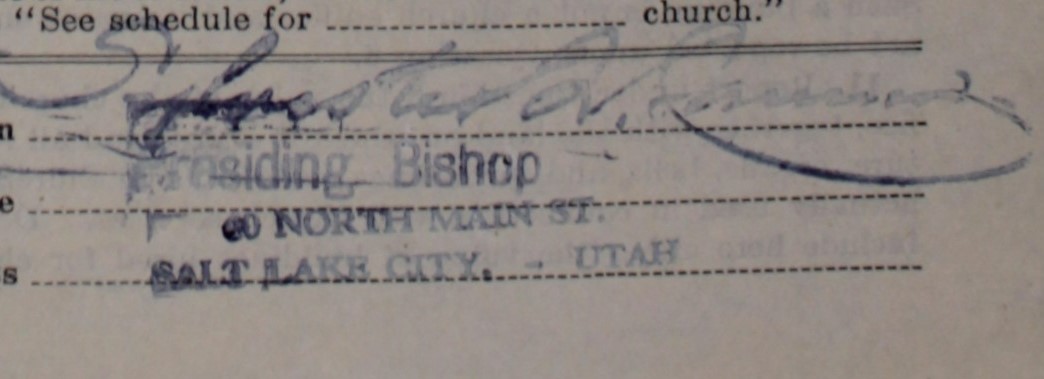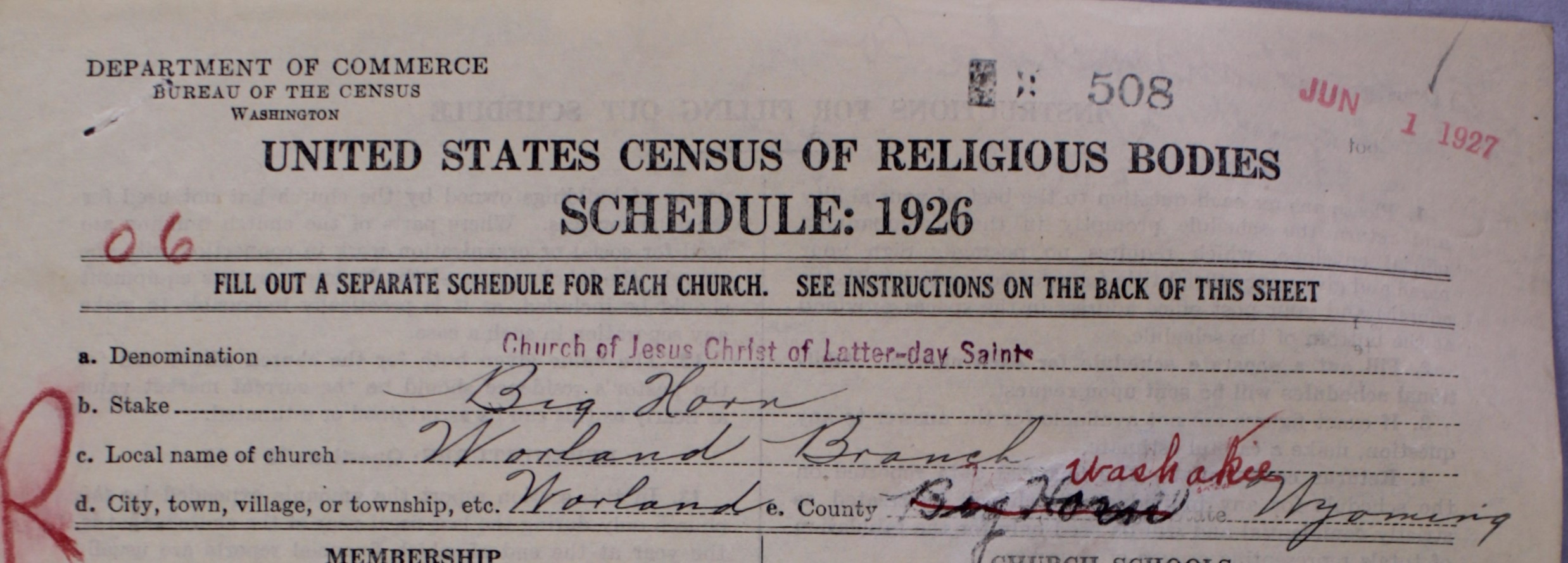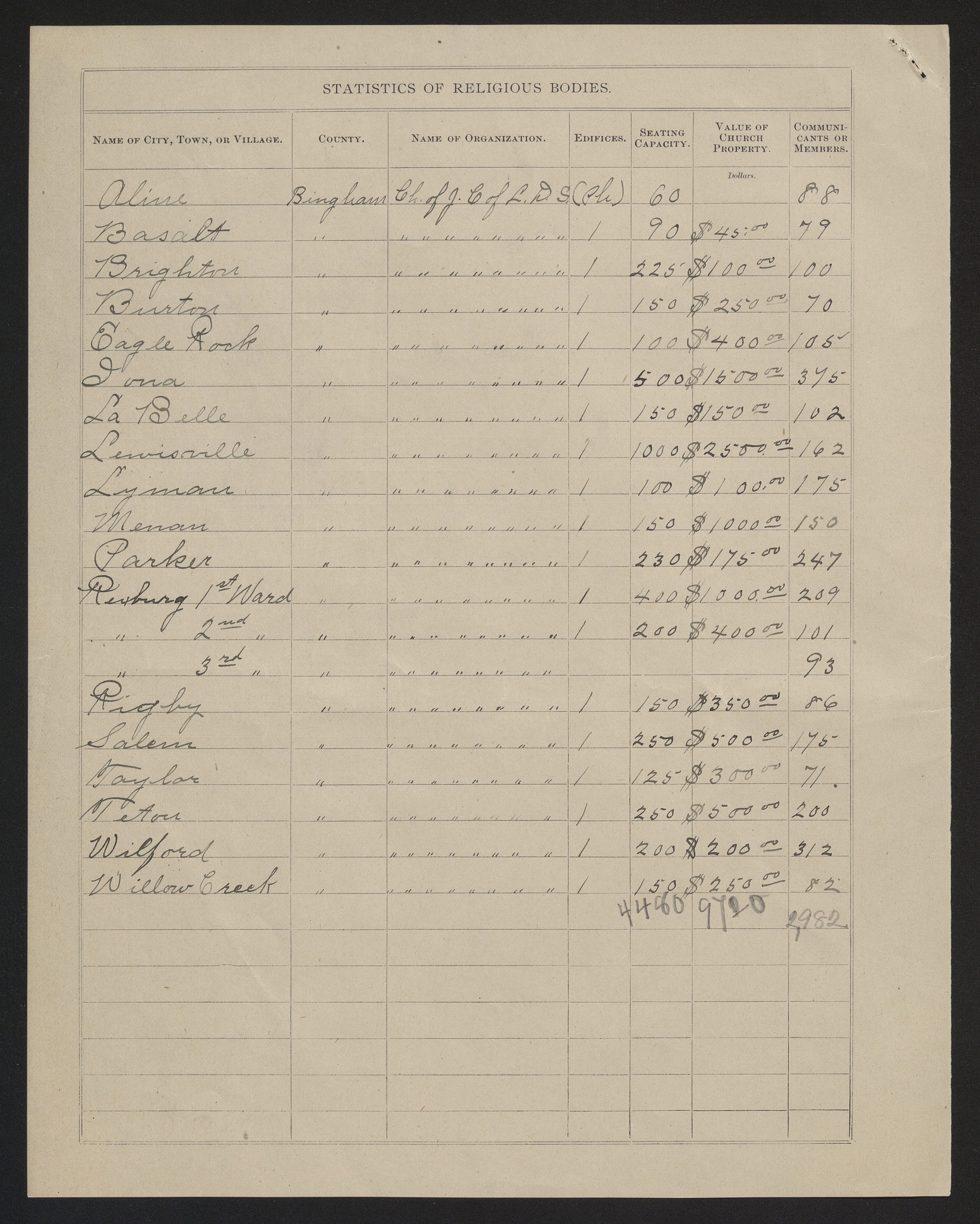The Latter-day Saints and the 1926 U.S. Census of Religious Bodies
For the 1926 U.S. Census of Religious Bodies, the Church of Jesus Christ of Latter-day Saints submitted more than 1,200 individual schedules.
Compared to many denominations, the LDS Church’s participation in the census was a highly centralized affair. Each schedule bears the stamped signature of Sylvester Q. Cannon, the church’s presiding bishop and a future member of the Quorum of the Twelve Apostles. The handwriting on at least most schedules is the same. The records of the Presiding Bishop’s Office in the Church History Library indicate that on March 7, 1927, church officials sent requests for statistical information to ward bishops for the Religious Bodies census. Local church leaders complied quickly, as the church stamped most of its completed schedules on May 25.

Figure 1. The stamped signature of Sylvester Q. Cannon, the church’s presiding bishop, who oversaw the church’s participation in the 1926 U.S. Census of Religious Bodies.
The centralized nature of the church’s effort is evident in the number of errors in the “County” field. On a significant number of schedules, Census Bureau officials corrected the “county.” Local leaders would have been unlikely to list their own county incorrectly. For reasons that are unclear, the Bureau devoted considerable time to double-checking the accuracy of town and county names on the Latter-day Saint schedules. The Bureau’s work was much less meticulous on the schedules of many other denominations.

Figure 2. The Census Bureau corrected the county for the Worland Branch to Washakie County, Wyoming.
Also, for reasons that are not clear, the schedules for some wards were entered on schedules that had been adapted for the geographic nomenclature of the church. On these, the Bureau asked church officials to identify a ward’s “stake,” a geographic unit akin to a diocese. On others, however, the Bureau asked for a congregation’s geographic division, such as “Association, Conference, Diocese, Presbytery, Synod”). On these schedules, church officials stamped “Stake” and then gave the stake name.
Even on the forms that had been partly adapted for the Latter-day Saint context, the Bureau asked church officials to identify a given ward or branch’s “Pastor” and then asked for the “number of ordained ministers, if any, employed as assistant pastors.” In the Church of Jesus Christ of Latter-day Saints, a bishopric presides over a ward or branch, and a bishopric consists of a bishop and two counselors. None of those individuals is “ordained” in a Protestant or Catholic sense. Like other men in good standing, these leaders hold the priesthood, but they are unpaid lay leaders. Given this ecclesiology, nearly all of the LDS schedules report two “assistant pastors.”

Figure 3. Like every other bishop of a Latter-day Saint ward, William F. Moncur had two counselors, listed here as “ordained … assistant pastors.”
To what extent are these 1,200-plus schedules useful to scholars? Or, put differently, do these schedules represent information not otherwise accessible in internal church publications or archival collections?
I have asked a few other scholars about the Latter-day Saint schedules and made inquiries at the Church History Library. According to Ardis Parshall, a Latter-day Saint historian and researcher, the church undertook its own internal census roughly every five years starting in 1914, and wards reported certain information to church officials every year. As far as I know, no church publications detail membership by ward in the early 1900s, nor would such publications include information such as the value of church edifices. It is likely that the records of the Presiding Bishop’s Office contain considerable information about the church’s internal censuses. Regardless, the Religious Bodies schedules represent a detailed set of data about Latter-day Saint wards and branches not easily accessible elsewhere.
The Census Bureau’s published data for its 1926 effort contains noteworthy information about the Latter-day Saints. For instance, the Church of Jesus Christ of Latter-day Saints was the only “principal denomination” with more male members than female members. Also, the church reported robust decade-over-decade growth, more than 34% between 1916 and 1926. Not surprisingly, the Bureau identified Utah as the “record” holder in terms of a predominant denomination, with 544 out of 714 congregations in Utah belonging to the Church of Jesus Christ of Latter-day Saints.
The published data is valuable, but the individual schedules will allow for a more granular portrait of the place of the Latter-day Saints on the American religious landscape. For instance, it is rather obvious that Utah was overwhelmingly Mormon in 1926, but the schedules will permit us to map the presence of Latter-day Saint wards and branches by populated place across the country. More granular comparisons will also be possible. For instance, the Bureau counted 1,275 Latter-day Saint “churches” and 592 “churches” in the Reorganized Church of Jesus Christ of Latter Day Saints. Using populated place-specific information from the schedules would enable us to view the presence of these two groups across the country.

Figure 4. Schedule for the Bannock Stake of the Church of Jesus Christ of Latter-day Saints in the 1890 Census. CR 4 98, Church History Library, Salt Lake City, Utah.
A final note on the Latter-day Saints and the U.S. Census Bureau. Prior to the establishment of the Census of Religious Bodies in the early 1900s, the Bureau already collected a significant amount of information in conjunction with its decennial population count. In 1890, for instance, at least some denominations submitted schedules to the Census Bureau. Few of those schedules remain extant. The Latter-day Saints, however, are without parallel in their record keeping, and a copy of their 1890 schedules is digitized and available through the Church History Library website. While those schedules do not contain as much information as their 1926 counterparts, they are a valuable source about the church’s membership and assets in 1890.
